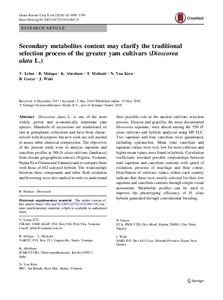| dc.contributor.author | Lebot, V. |
| dc.contributor.author | Malapa, R. |
| dc.contributor.author | Abraham, K. |
| dc.contributor.author | Molisale, T. |
| dc.contributor.author | Van Kien, N. |
| dc.contributor.author | Gueye, B. |
| dc.contributor.author | Waki, J. |
| dc.date.accessioned | 2019-12-04T11:26:31Z |
| dc.date.available | 2019-12-04T11:26:31Z |
| dc.date.issued | 2018-08 |
| dc.identifier.citation | Lebot, V., Malapa, R., Abraham, K., Molisalé, T., Van Kien, N., Gueye, B. & Waki, J. (2018). Secondary metabolites content may clarify the traditional selection process of the greater yam cultivars (Dioscorea alata L.). Genetic Resources and Crop Evolution, 65(6), 1699-1709. |
| dc.identifier.issn | 0925-9864 |
| dc.identifier.uri | https://hdl.handle.net/20.500.12478/4639 |
| dc.description | Published online: 15 May 2018 |
| dc.description.abstract | Dioscorea alata L. is one of the most widely grown and economically important yam species. Hundreds of accessions are maintained ex situ in germplasm collections and have been characterized with descriptors but new tools are still needed to assess tuber chemical composition. The objectives of the present study were to analyze saponins and catechins profiles in 388 D. alata cultivars (landraces) from distant geographical sources (Nigeria, Vietnam, Papua New Guinea and Vanuatu) and to compare them with those of 162 selected hybrids. The relationships between these compounds and tuber flesh oxidation and browning were also studied in order to understand their possible role in the ancient cultivars selection process. Dioscin and gracillin, the most documented Dioscorea saponins, were absent among the 550 D. alata cultivars and hybrids analyzed using HP-TLC. Two saponins and four catechins were quantitated, including epicatechin. Mean total catechins and saponins values were very low for most cultivars and higher mean values were found in hybrids. Correlation coefficients revealed possible relationships between total saponins and catechins contents with speed of oxidation, presence of mucilage and flour colour. Distribution of cultivars values within each country indicate that these were mostly selected for their low saponins and catechins contents through simple visual assessment. Metabolite profiles can be used to improve the phenotyping efficiency of D. alata hybrids generated through conventional breeding. |
| dc.description.sponsorship | Agropolis Fondation |
| dc.format.extent | 1699-1709 |
| dc.language.iso | en |
| dc.rights | Other |
| dc.subject | Dioscorea Alata |
| dc.subject | Domestication |
| dc.subject | Saponins |
| dc.subject | Tuber |
| dc.title | Secondary metabolites content may clarify the traditional selection process of the greater yam cultivars (Dioscorea alata L.) |
| dc.type | Journal Article |
| dc.description.version | Peer Review |
| cg.contributor.crp | Genebanks |
| cg.contributor.affiliation | Centre de Coopération Internationale en Recherche Agronomique pour le Développement |
| cg.contributor.affiliation | Vanuatu Agricultural Research and Technical Centre |
| cg.contributor.affiliation | Central Tuber Crops Research Institute |
| cg.contributor.affiliation | Plant Resources Center, Vietnam |
| cg.contributor.affiliation | International Institute of Tropical Agriculture |
| cg.contributor.affiliation | National Agricultural Research Institute, Papua New Guinea |
| cg.creator.identifier | Badara GUEYE: 0000-0003-3157-8772 |
| cg.researchtheme | BIOTECH & PLANT BREEDING |
| cg.isijournal | ISI Journal |
| cg.authorship.types | CGIAR and developing country institute |
| cg.iitasubject | Plant Breeding |
| cg.journal | Genetic Resources and Crop Evolution |
| cg.howpublished | Formally Published |
| cg.accessibilitystatus | Limited Access |
| local.dspaceid | 101350 |
| cg.targetaudience | Scientists |
| cg.identifier.doi | https://dx.doi.org/10.1007/s10722-018-0647-0 |

